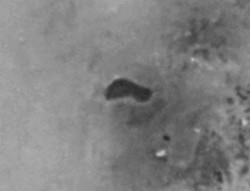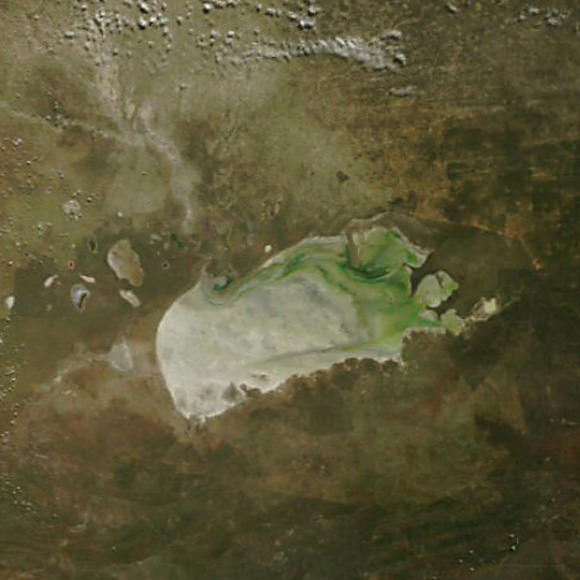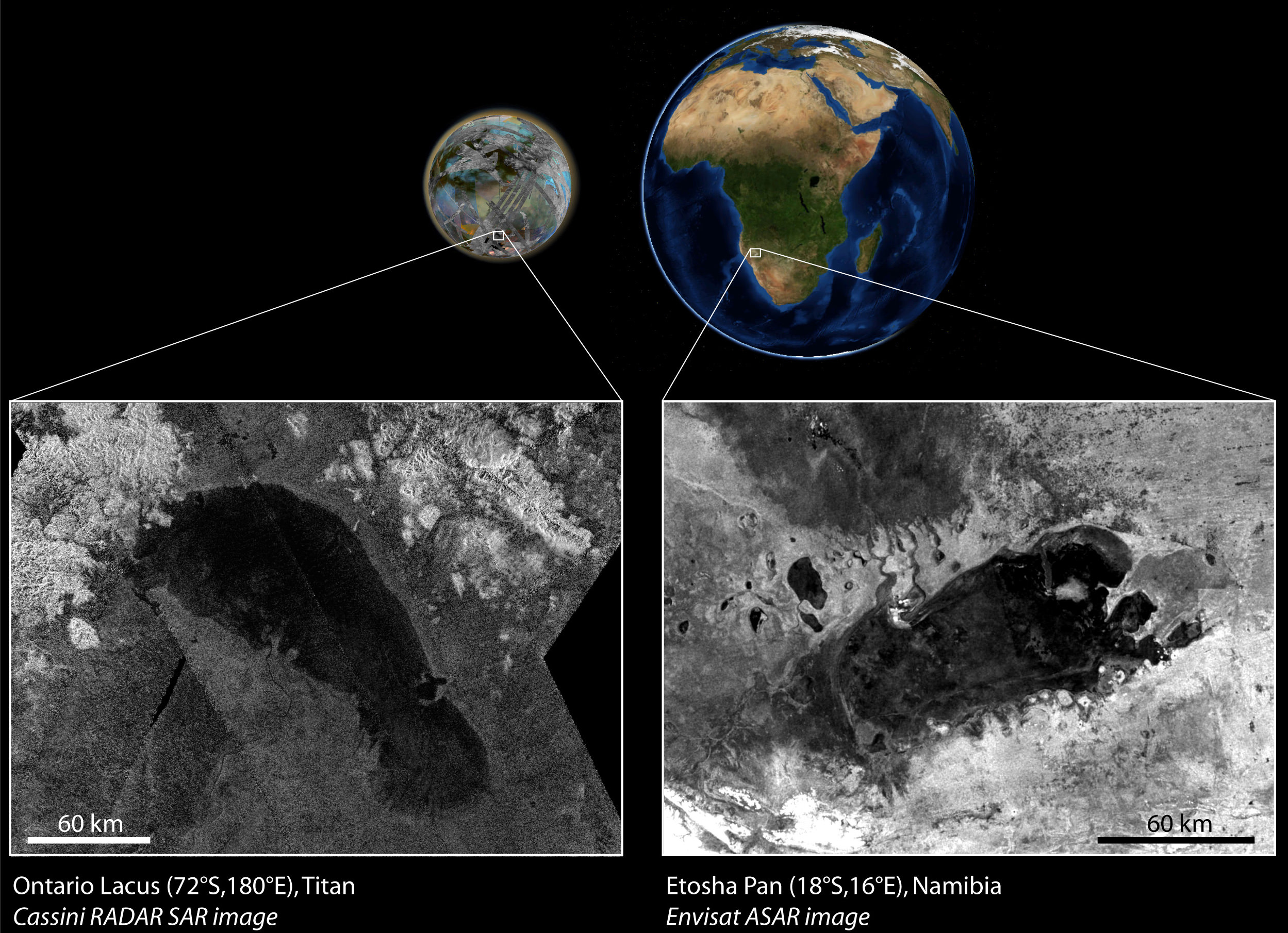[/caption]
A large lake on Saturn’s cloud-covered Titan seems very similar to the Etosha Pan, a salt-encrusted dry lakebed in northern Namibia that periodically fills with water. As it turns out, Titan’s “great lake” may also be temporary.
Ontario Lacus, so named because of its similarity both in shape and size to Lake Ontario here on Earth, was first discovered near the south pole of Titan by the Cassini spacecraft in 2009. Its smooth, dark appearance in radar images indicated a uniform and reflective surface, implying a large — although likely shallow — body of liquid.
Of course, on Titan the liquid isn’t water — it’s methane, which is the main ingredient of the hydrologic cycle found on the giant moon. That far from the Sun the temperatures at Titan’s poles fall to a frigid -300ºF (-185ºC), much too cold for water to exist as a liquid and so, on this world, methane has taken its place.
A research team led by Thomas Cornet of the Université de Nantes, France has taken a closer look at Cassini’s radar data of Ontario Lacus and found evidence of channels carved into the southern portion. According to the team, this likely indicates that the lakebed surface is exposed.

“We conclude that the solid floor of Ontario Lacus is most probably exposed in those areas,” said Cornet.
In addition, sediment layers surrounding the lake suggest that the liquid level has varied.
All in all, this reveals a striking resemblance between Ontario Lacus and Namibia’s Etosha Pan — an “ephemeral lake” that is dry for much of the year, occasionally filling with a shallow layer of water which evaporates, leaving salty rings of sediment.
The inherent otherworldly nature of Etosha Pan is further underlined — and perhaps foreshadowed! — by its use as a backdrop in the 1968 sci-fi film 2001: A Space Odyssey.
Although Ontario Lacus was initially thought to be permanently filled with liquid hydrocarbons, the team’s findings draw a strong correlation with this well-known Earthly environment, suggesting a much more temporary nature and showing the value of comparative research.

“These results emphasise the importance of comparative planetology in modern planetary sciences,” said Nicolas Altobelli, Cassini project scientist for ESA.”Finding familiar geological features on alien worlds like Titan allows us to test the theories explaining their formation.”
Read the press release from ESA here.
Image credits: Cassini radar image JPL/NASA. Envisat radar image ESA. Composite image: LPGNantes.


Both of these lakes seem to be rather pedestrian.
Strange that nobody noticed that there is a giant stranded whale on the bottom right bank of the lake 😀
Methane rocket engines anybody? Imagine a near light speed spacecraft using methane as part of the propulsion system. If so, then one might search out places like Titan for fuel?
Just passing through…
If we were advanced enough to get all the way to Titan to mine methane, why wouldn’t we just mine Saturn for it’s hydrogen? Anything methane can do hydrogen can do just as well if not better and hydrogen is far more abundant in the universe. Besides, we already have hydrogen powered rockets and they can’t get us anywhere near light speed. There are at this time only two possibilities for achieving a sizable fraction of light speed and those are Fusion and Antimatter and both are still only theory.
Or LCs favorite, solar sails.
But if Aqua4U can make a pit stop to get to some of that ethane and possibly higher hydrocarbons, they can get him further speeding all right:
“The effects of inhalants range from an alcohol-like intoxication and intense euphoria to vivid hallucinations, depending on the substance and the dosage.”
What I actually had in mind would be that an advanced space fairing culture might collect then ‘crack’ the methane – separate the hydrogen then ‘shock’ compress it into a solid in pellet form. Those pellets are then injected into a plasma fusion chamber as fuel? Putt-putt-putt…
Could work, but you could save alot of time and effort by just collecting what you need. If all your looking for is hydrogen, then just collect hydrogen its far more common any way. Besides if splitting molecules is no problem then collecting water would make more sense. Split methane you end up with carbon, split water you end up with oxygen.
What I actually had in mind would be that an advanced space fairing culture might collect then ‘crack’ the methane – separate the hydrogen then ‘shock’ compress it into a solid in pellet form. Those pellets are then injected into a plasma fusion chamber as fuel? Putt-putt-putt…
Thanks to Cassini team who made possible to see…